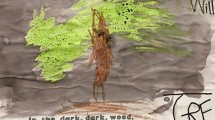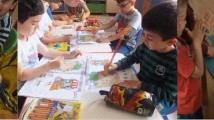Abstract
Despite the importance of early writing development to children’s school success, research documents that early childhood teachers spend little time actively supporting children’s writing development in preschool classrooms. This article provides a framework for integrating writing experiences across the early childhood curriculum. Practical examples are given regarding how writing opportunities can be incorporated into existing activities and play settings. The metaphor of backgrounding and foregrounding writing experiences is used to illustrate ways that teachers can set writing rich environments and activities in a manner that makes it easier for teachers to bring these experiences into everyday learning opportunities. Attention is given to how teachers can bring writing to the foreground of the curriculum by drawing attention to writing materials, making natural connections with children’s interest and play, and scaffolding children’s early writing attempts and experiences.



Similar content being viewed by others
References
Aram, D. (2005). Continuity in children’s literacy achievements: A longitudinal perspective from kindergarten to school. First Language, 25(3), 259–289.
Aram, D., & Biron, S. (2004). Joint storybook reading and joint writing interventions among low SES preschoolers: Differential contributions to early literacy. Early Childhood Research Quarterly, 19(4), 588–610.
Ashiabi, G. S. (2007). Play in the preschool classroom: Its socioemotional significance and the teacher’s role in play. Early Childhood Education Journal, 35(2), 199–207.
Bingham, G. E., Quinn, M. F., & Gerde, H. K. (2017). Examining early childhood teachers’ writing practices: Associations between pedagogical supports and children’s writing skills. Early Childhood Research Quarterly, 39, 35–46.
Cabell, S. Q., Tortorelli, L. S., & Gerde, H. K. (2013). “How do I write… Scaffolding preschoolers’ early writing skills. The Reading Teacher, 66(8), 650–659.
Christie, J. F., & Roskos, K. A. (2015). How does play contribute to literacy? In J. E. Johnson, S. G. Eberle, T. S. Hendricks & D. Kuschner (Eds.), The handbook of the study of play (Vol. 2, pp. 417–424). Lanham, MD: Rowman & Littlefield.
Early, D. M., Iruka, I. U., Ritchie, S., Barbarin, O. A., Winn, D.-M. C., Crawford, G. M., … Pianta, R. C. (2010). How do pre-kindergarteners spend their time? Gender, ethnicity, and income as predictors of experiences in pre-kindergarten classrooms. Early Childhood Research Quarterly, 25(2), 177–193.
Fromberg, D. P., & Bergen, D. (2006). Play from birth to twelve: Contexts, perspectives, and meanings. New York, NY: Taylor & Francis.
Gerde, H. K., Bingham, G. E., & Pendergast, M. L. (2015). Reliability and validity of the Writing Resources and Interactions in Teaching Environments (WRITE) for preschool classrooms. Early Childhood Research Quarterly, 31, 34–46.
Gerde, H., Bingham, G. E., & Wasik, B. A. (2012). Writing in early childhood classrooms: Guidance for best practices. Early Childhood Education Journal, 40, 351–359.
Graves, D. (2003). Writing: Teachers and children at work. Portsmouth, NH: Heinemann.
Guo, Y., Justice, L. M., Kaderavek, J. N., & McGinty, A. (2012). The literacy environment of preschool classrooms: Contributions to children’s emergent literacy growth. Journal of Research in Reading, 35(3), 308–327.
Hammill, D. D. (2004). What we know about correlates of reading. Teaching Exceptional Children, 70(4), 453–469.
Justice, L. M., Mashburn, A. J., Hamre, B. K., & Pianta, R. C. (2008). Quality of language and literacy instruction in preschool classrooms serving at-risk pupils. Early Childhood Research Quarterly, 23(1), 51–68.
Kaderavek, J. N., Cabell, S. Q., & Justice, L. M. (2009). Early writing and spelling development. In P. M. Rymer (Ed.), Emergent literacy and language development: Promoting learning in early childhood (pp. 104–152). New York, NY: Guilford.
Kissel, B., Hansen, J., Tower, H., & Lawrence, J. (2011). The influential interactions of pre-kindergarten writers. Journal of Early Childhood Literacy, 11(4), 425–452.
National Early Literacy Panel (NELP). (2008). Developing early literacy: Report of the national early literacy panel. Washington, DC: National Institute for Literacy.
National Governors Association Center for Best Practices. (2010). Common core state standards (K literacy). Washington D.C.: National Governors Association Center for Best Practices.
Neitzel, C., Alexander, J. M., & Johnson, K. E. (2008). Children’s early interest-based activities in the home and subsequent information contributions and pursuits in kindergarten. Journal of Educational Psychology, 100(4), 782–797.
Neuman, S. B., & Roskos, K. (1990). Play, print, and purpose: Enriching play environments for literacy development. The Reading Teacher, 44(3), 214–221.
Neuman, S. B., Roskos, K., Wright, T., & Lenhart, L. (2007). Nurturing knowledge: Linking literacy to math, science, social studies and much more. New York: Scholastic.
Pelatti, C. Y., Piasta, S. B., Justice, L. M., & O’Connell, A. (2014). Language- and literacy-learning in early childhood classrooms: Children’s typical experiences and within-classroom variability. Early Childhood Research Quarterly, 29(4), 445–456.
Puranik, C. S., & Lonigan, C. J. (2014). Emergent writing in preschoolers: Preliminary evidence for a theoretical framework. Reading Research Quarterly, 49(4), 453–467.
Quinn, M. F., Gerde, H. K., & Bingham, G. E. (2016). Help me where I am: Scaffolding writing in preschool classrooms. The Reading Teacher, 70, 353–357.
Roskos, K. A., & Christie, J. F. (2007). Play in the context of the new preschool basics. In K. A. Roskos & J. F. Christie (Eds.), Play and literacy in early childhood: Research from multiple perspectives (pp. 83–100). Mahwah, NJ: Erlbaum.
Roskos, K. A., Christie, J. F., & Richgels, D. J. (2003). The essentials of early literacy. Young Children, 58(2), 52–60.
Roskos, K., & Neuman, S. B. (2011). The classroom environment. The Reading Teacher, 65(2), 110–114.
Rowe, D. W., & Neitzel, C. (2010). Interest and agency in 2- and 3-year olds’ participation in emergent writing. Reading Research Quarterly, 45(2), 169–195.
Shatil, E., Share, D. L., & Levin, I. (2000). On the contribution of kindergarten spelling to Grade 1 literacy: A longitudinal study in Hebrew. Applied Psycholinguistics, 21, 1–21.
Stroud, J. E. (1995). Block play: Building a foundation for literacy. Early Childhood Education Journal, 23, 9–13.
Tongson, E. C. (2014). Teacher’s interaction styles during sociodramatic play that promote reading and writing among preschoolers. Social Science Diliman, 10(2), 56–99.
Torterelli, L. S., Barria, R., & Goetsch, M. (2016). Ready, set, write! Preschool and kindergarten writing standards. In Paper presented at the annual meeting of the Literacy Research Association. Nashville, TN.
Treiman, R., Kessler, B., Decker, K., & Pollo, T. C. (2016). How do prephonological writers link written words to their objects? Cognitive Development, 38, 89–98.
Wheatley, B. C., Gerde, H. K., & Cabell, S. Q. (2016). Integrating early writing into science instruction in preschool. The Reading Teacher, 70, 83–92.
Funding
Funding was provided by Institute of Education Sciences (Grant No. R305A150210).
Author information
Authors and Affiliations
Corresponding author
Rights and permissions
About this article
Cite this article
Bingham, G.E., Quinn, M.F., McRoy, K. et al. Integrating Writing into the Early Childhood Curriculum: A Frame for Intentional and Meaningful Writing Experiences. Early Childhood Educ J 46, 601–611 (2018). https://doi.org/10.1007/s10643-018-0894-x
Published:
Issue Date:
DOI: https://doi.org/10.1007/s10643-018-0894-x




